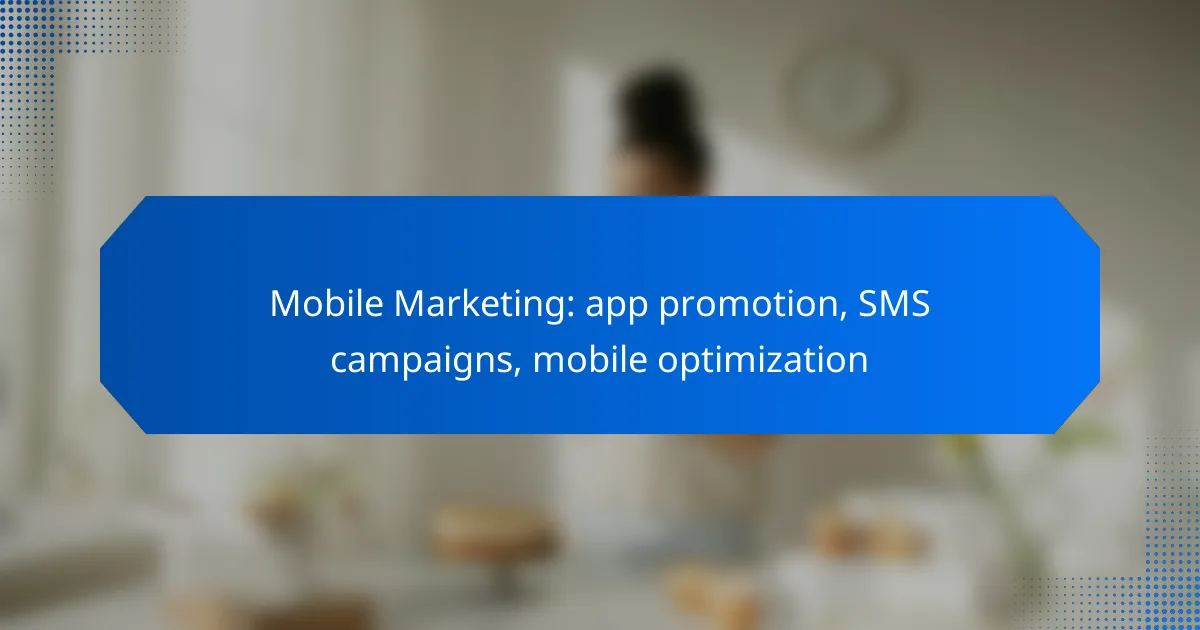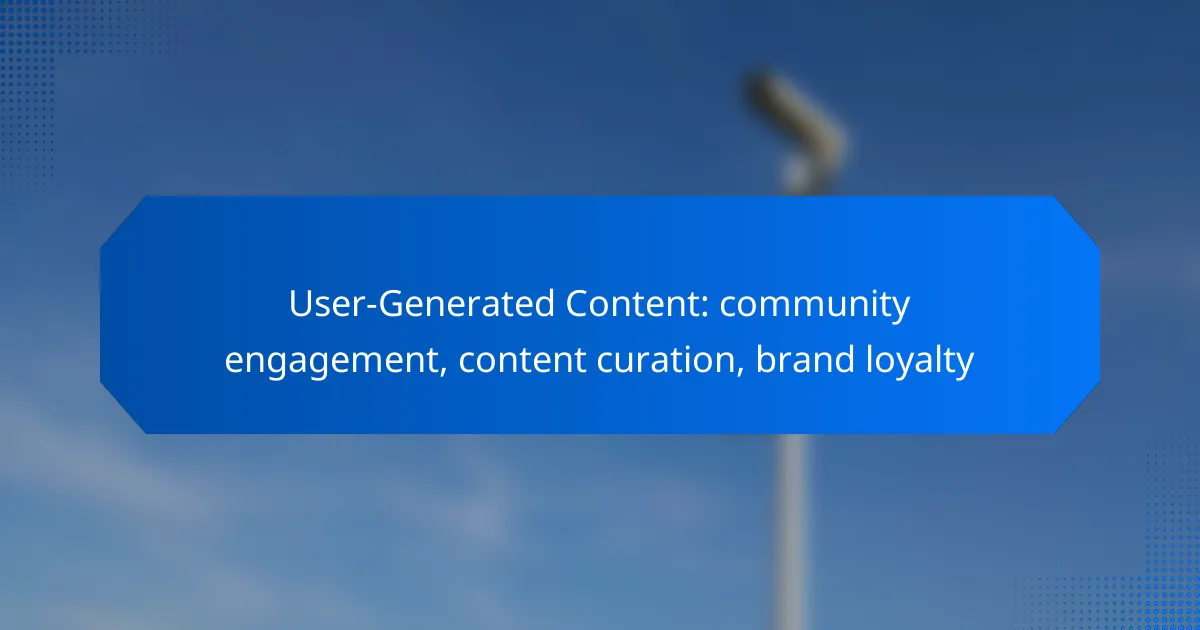
Mobile marketing is essential for reaching today’s on-the-go consumers, with strategies like app promotion, SMS campaigns, and mobile optimization playing pivotal roles. By leveraging targeted advertising and engaging content, businesses can effectively enhance user acquisition and retention. Additionally, optimizing mobile websites ensures a seamless experience that boosts both engagement and search engine visibility.

How to promote mobile apps effectively in Australia?
To promote mobile apps effectively in Australia, focus on targeted advertising, social media engagement, and optimizing app store visibility. These strategies can significantly enhance user acquisition and retention in a competitive market.
Utilize Google Ads for app promotion
Google Ads offers a powerful platform for promoting mobile apps through targeted campaigns. By using app promotion ads, you can reach potential users on Google Search, YouTube, and across the Google Display Network.
Consider setting a budget that aligns with your marketing goals. A common approach is to allocate a portion of your overall marketing budget specifically for app promotion, ensuring you can test different ad formats and optimize based on performance.
Leverage social media platforms like Facebook and Instagram
Social media platforms such as Facebook and Instagram are essential for mobile app promotion due to their vast user bases and targeting capabilities. Create engaging content that highlights your app’s features and benefits to attract users.
Utilize paid ads on these platforms to reach specific demographics. For instance, targeting users based on interests or behaviors can lead to higher conversion rates. Regularly analyze engagement metrics to refine your strategy.
Implement influencer marketing strategies
Influencer marketing can significantly boost your app’s visibility by leveraging the trust and reach of popular figures in your niche. Collaborate with influencers who align with your brand to create authentic content that showcases your app.
When selecting influencers, consider their audience demographics and engagement rates. Micro-influencers often yield high engagement at a lower cost, making them a viable option for app promotion.
Optimize app store listings for visibility
Optimizing your app store listings is crucial for improving visibility and attracting downloads. Focus on using relevant keywords in your app title and description to enhance searchability.
Incorporate high-quality visuals, such as screenshots and videos, to demonstrate your app’s functionality. Regularly update your app based on user feedback to maintain a positive rating and encourage downloads.

What are the best practices for SMS marketing campaigns?
Effective SMS marketing campaigns require careful planning and execution to maximize engagement and conversion rates. Key practices include personalizing messages, segmenting your audience, and using clear calls-to-action to drive desired responses.
Personalize messages for higher engagement
Personalization in SMS marketing involves tailoring messages to individual recipients based on their preferences, behaviors, or demographics. Using the recipient’s name and relevant offers can significantly increase engagement rates.
For example, a retail brand might send a personalized discount code to customers who have previously purchased similar items. This approach not only makes the message feel more relevant but also encourages recipients to take action.
Segment audience for targeted campaigns
Segmenting your audience allows you to create targeted SMS campaigns that resonate with specific groups. By dividing your audience based on criteria such as purchase history, location, or interests, you can craft messages that are more likely to appeal to each segment.
For instance, a restaurant could send different promotions to local customers versus those who are visiting from out of town. This targeted approach can lead to higher response rates and improved customer satisfaction.
Utilize clear call-to-action in messages
A clear call-to-action (CTA) is essential in SMS marketing to guide recipients on what to do next. Whether it’s visiting a website, redeeming a coupon, or signing up for an event, a strong CTA helps eliminate confusion and encourages immediate responses.
For example, instead of a vague message like “Check out our new products,” a more effective CTA would be “Text ‘SAVE10’ to get 10% off your next purchase!” This specificity not only clarifies the action but also adds a sense of urgency.

How to optimize mobile websites for better performance?
To optimize mobile websites for better performance, focus on responsive design, fast loading times, and user-friendly navigation. These elements are crucial for enhancing user experience and improving search engine rankings.
Implement responsive design for all devices
Responsive design ensures that your website adapts seamlessly to various screen sizes and orientations. This approach eliminates the need for separate mobile sites, simplifying maintenance and improving user experience.
Utilize CSS media queries to adjust layout elements based on device characteristics. Test your site on multiple devices to confirm that content displays correctly and is easily accessible.
Improve page load speed with optimized images
Page load speed is critical for retaining visitors. Optimize images by compressing them without sacrificing quality, which can significantly reduce loading times. Aim for image sizes under 100 KB where possible.
Consider using modern formats like WebP for better compression. Implement lazy loading to defer loading images until they are in the viewport, enhancing initial load speed.
Ensure easy navigation and user experience
Simple navigation is essential for mobile users, who often seek quick access to information. Use a clear menu structure and limit the number of menu items to enhance usability.
Incorporate touch-friendly buttons and ensure that links are easily clickable. Test your site’s navigation on various devices to identify any potential issues that could frustrate users.

What are the key metrics for measuring mobile marketing success?
Key metrics for measuring mobile marketing success include app downloads, user retention rates, SMS campaign performance, and website traffic analytics. These metrics provide insights into user engagement and the effectiveness of marketing strategies.
Track app downloads and user retention rates
Monitoring app downloads is crucial as it indicates the initial interest in your mobile application. A high number of downloads suggests effective promotion, but retention rates reveal how well users engage with the app over time.
To improve retention, focus on user experience and regular updates. Aim for a retention rate of at least 20-30% after the first month, as this indicates that users find value in your app. Consider implementing push notifications to encourage users to return.
Measure SMS campaign open and click-through rates
SMS campaigns are highly effective due to their immediacy, with open rates often exceeding 90%. Tracking open and click-through rates helps assess the impact of your messaging and offers.
For optimal results, aim for a click-through rate of around 15-25%. Personalizing messages and including clear calls to action can significantly enhance engagement. Avoid sending too many messages to prevent user fatigue and opt-out rates.
Analyze website traffic and conversion rates
Website traffic analysis reveals how mobile marketing drives users to your site. Key metrics include the number of visitors, session duration, and bounce rates, which indicate user engagement levels.
Conversion rates are equally important as they measure the percentage of visitors completing desired actions, such as making a purchase or signing up for a newsletter. A conversion rate of 2-5% is typical for e-commerce sites. Use A/B testing to optimize landing pages and improve these rates.

What tools can enhance mobile marketing strategies?
Several tools can significantly improve mobile marketing strategies by providing insights, tracking performance, and facilitating communication. Utilizing the right tools can streamline your efforts, enhance user engagement, and ultimately drive conversions.
Use Google Analytics for performance tracking
Google Analytics is essential for tracking the performance of mobile marketing campaigns. It offers insights into user behavior, traffic sources, and conversion rates, allowing marketers to assess the effectiveness of their strategies.
To get started, set up mobile tracking by ensuring your website is optimized for mobile users. Monitor key metrics such as bounce rates and session durations to identify areas for improvement. Regularly review reports to adjust your campaigns based on real-time data.
Employ Mailchimp for SMS and email campaigns
Mailchimp is a powerful platform for managing SMS and email marketing campaigns. It allows businesses to create targeted campaigns based on user preferences and behaviors, enhancing engagement and conversion rates.
When using Mailchimp, segment your audience to send personalized messages that resonate with different user groups. Keep your content concise and compelling, and consider A/B testing different messages to determine what works best. Ensure compliance with regulations like GDPR when collecting user data.
Utilize App Annie for app market insights
App Annie provides valuable insights into app market trends, helping marketers understand competitive landscapes and user preferences. This tool can inform your app promotion strategies and optimize user acquisition efforts.
Leverage App Annie to analyze download trends, revenue estimates, and user demographics. Use this data to refine your marketing strategies, focusing on features and messaging that align with user interests. Regularly check competitor performance to identify opportunities for differentiation.

What are the emerging trends in mobile marketing?
Emerging trends in mobile marketing focus on personalization, automation, and enhanced user experiences. As technology evolves, marketers are leveraging data to create targeted campaigns that resonate with users on their mobile devices.
App Promotion Strategies
App promotion strategies are increasingly centered around user engagement and retention. Marketers are utilizing social media platforms, influencer partnerships, and targeted ads to reach potential users effectively. Offering incentives such as discounts or exclusive content can also drive downloads.
Consider using app store optimization (ASO) techniques to improve visibility in app stores. This includes optimizing keywords, visuals, and descriptions to attract more downloads. Regularly updating the app with new features can keep users engaged and encourage positive reviews.
SMS Campaigns
SMS campaigns are a powerful tool for direct communication with customers. They boast high open rates, often exceeding 90%, making them effective for time-sensitive promotions or important updates. However, it’s crucial to obtain consent before sending messages to comply with regulations.
To maximize the effectiveness of SMS campaigns, keep messages concise and include a clear call to action. Personalization can enhance engagement, so consider using the recipient’s name or tailoring offers based on previous interactions. Avoid overloading users with messages to prevent opt-outs.
Mobile Optimization Techniques
Mobile optimization techniques ensure that websites and applications provide a seamless user experience on mobile devices. This includes responsive design, fast loading times, and easy navigation. A well-optimized mobile site can significantly reduce bounce rates and improve conversion rates.
Implementing AMP (Accelerated Mobile Pages) can enhance loading speed, while minimizing pop-ups and intrusive ads can improve user satisfaction. Regularly testing your mobile site across various devices and screen sizes is essential to identify and resolve any usability issues.


